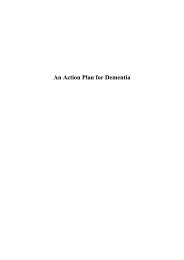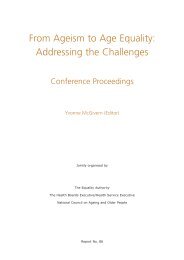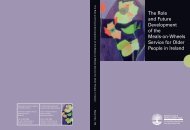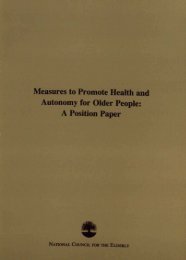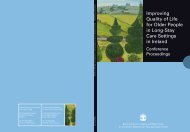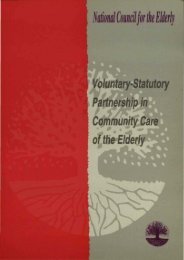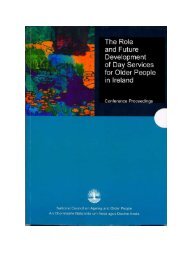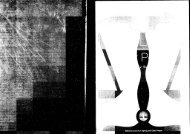Assessment of Older People's Health and Social Care Needs and ...
Assessment of Older People's Health and Social Care Needs and ...
Assessment of Older People's Health and Social Care Needs and ...
- No tags were found...
Create successful ePaper yourself
Turn your PDF publications into a flip-book with our unique Google optimized e-Paper software.
Background to the Development <strong>of</strong> the <strong>Assessment</strong> ToolIn terms <strong>of</strong> ole"r people, PHN's concentrate on providing a service to older people aged 75 years<strong>and</strong> over. The service includes provision <strong>of</strong> a surveillance programme, screening programme,monitoring <strong>of</strong> the elderly at risk <strong>and</strong> treatment <strong>and</strong> care service. PHN's by tradition maintain aregister <strong>of</strong> persons at risk, but the criteria for inclusion have not yet been st<strong>and</strong>ardised at regionalor national level. The PHN department in the WHB, conscious <strong>of</strong> the need to st<strong>and</strong>ardise criteriafor identifying older people at risk, set about developing a procedure for functional assessmentscreening <strong>of</strong> the elderly by PHN's which would be consistent throughout the health board area. ARegional Working Group, comprising PHNs, DPHNs <strong>and</strong> a Consultant Geriatrician was established towork on the project.Development <strong>of</strong> the ToolFour criteria were observed in developing the Functional <strong>and</strong> <strong>Social</strong> <strong>Assessment</strong> Tool. It needed to:• be brief• be easy to carry out• involve no extra cost• be pertinent for use in home/community settings by PHNs.The first goal in developing the tool was to identify unappreciated functional disabilities that shouldbe systematically reviewed for older people. After the list was formulated, suitable procedures toevaluate the disabilities were devised. A pilot study was carried out in 1993 <strong>and</strong> the screeningprogramme introduced in 1994, following education <strong>of</strong> all PHNs in the region on the use <strong>and</strong>interpretation <strong>of</strong> the findings.The WHB Functional <strong>and</strong> <strong>Social</strong> <strong>Assessment</strong> ToolThe WHB tool was divided into functional assessment <strong>and</strong> social assessment. Many <strong>of</strong> the functionalproblems <strong>of</strong> older people are relatively minor, but can have a significant effect on the quality <strong>of</strong> life.Screening has an important part to play in helping people to realise that their problems are not part<strong>of</strong> a normal ageing process <strong>and</strong> that solutions can be found. Functional assessment is <strong>of</strong> the olderperson's vision, hearing, continence, mental status, vulnerability to falls <strong>and</strong> mobility. <strong>Social</strong>assessment is <strong>of</strong> the older people's social support (for example who they would call in anemergency); their social risk (for example, whether they are in need <strong>of</strong> support services); theireconomic situation; their housing <strong>and</strong> house-keeping ability.Limitations <strong>of</strong> the WHB ToolPHNS in the WHB found that the functional <strong>and</strong> social assessment tool was easy to use. However,they have also identified some limitations. These are as follows:• it did not necessarily identify people at risk• the carer's opinion was not taken into account• it did not highlight persons suffering physical <strong>and</strong> emotional abuse due to family stress <strong>and</strong>disharmonyConference Proceedings





